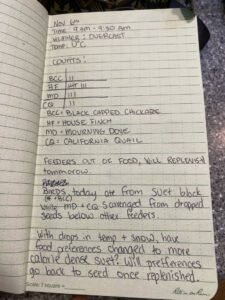LnRiLWZpZWxke21hcmdpbi1ib3R0b206MC43NmVtfS50Yi1maWVsZC0tbGVmdHt0ZXh0LWFsaWduOmxlZnR9LnRiLWZpZWxkLS1jZW50ZXJ7dGV4dC1hbGlnbjpjZW50ZXJ9LnRiLWZpZWxkLS1yaWdodHt0ZXh0LWFsaWduOnJpZ2h0fS50Yi1maWVsZF9fc2t5cGVfcHJldmlld3twYWRkaW5nOjEwcHggMjBweDtib3JkZXItcmFkaXVzOjNweDtjb2xvcjojZmZmO2JhY2tncm91bmQ6IzAwYWZlZTtkaXNwbGF5OmlubGluZS1ibG9ja311bC5nbGlkZV9fc2xpZGVze21hcmdpbjowfQ==
IEBtZWRpYSBvbmx5IHNjcmVlbiBhbmQgKG1heC13aWR0aDogNzgxcHgpIHsgICB9IEBtZWRpYSBvbmx5IHNjcmVlbiBhbmQgKG1heC13aWR0aDogNTk5cHgpIHsgICB9IA==
- Identify the organism or biological attribute that you plan to study.
- I plan to study bird activity at a single feeding station. Specifically, how is bird activity affected by easy to access food sources like bird feeders with seed vs. natural occurring food sources like berries and other forage present in the study site.
- Use your field journal to document observations of your organism or biological attribute along an environmental gradient. Choose at least three locations along the gradient and observe and record any changes in the distribution, abundance, or character of your object of study.
- Gradient: The environmental gradient would be related to food availability with High availability at the feeder, Med availability at the naturally occurring berry bushes and low availability everywhere else in the yard.
- House Finches were rarely/never seen at the bird feeder or within the study site if no bird seed was present and didn’t appear to eat at any of the natural sites or Suet block
- Quail were sporadically present below the feeder and elsewhere through the yard but did not seem particularly drawn to the bird feeder
- Dark-eyed Juncos were consistently present underneath the bird feeder feeding on seeds thrown down by the House Finches, they did not seem interested in eating from the berry bushes but were seen sporadically foraging through the rest of the yard.
- Think about underlying processes that may cause any patterns that you have observed. Postulate one hypothesis and make one formal prediction based on that hypothesis. Your hypothesis may include the environmental gradient; however, if you come up with a hypothesis that you want to pursue within one part of the gradient or one site, that is acceptable as well.
- If bird seed is present in a feeder then more individuals and species will congregate at the feeder than would be present in natural conditions.
- I predict that as time increases and more birds discover the feeder, higher bird activity will occur. If food is then removed, bird species will quickly redistribute to surrounding food sources and bird activity will steeply decline.
- Based on your hypothesis and prediction, list one potential response variable and one potential explanatory variable and whether they would be categorical or continuous. Use the experimental design tutorial to help you with this.
- Response Variable: Number of individual birds observed
- Explanatory Variable: Presence of bird-seed in feeder
- Both variables would be categorical in nature and would require a Tabular study design.


Why use the bird feeder at all? Why not find a gradient within your backyard. You don’t give a lot of information about how big your yard is or what other types of vegetation are present though this may be possible. If you have some different types of berry bushes or plants that may have seeds, insects or other food sources then you could do observations at each of these and not include the bird feeder. In many ways I find this a more interesting ecological question because it seems obvious to me that you will get more birds as they find a bird feeder and I don’t see a real ecological question here. You also do not need a month of data, you will need some replication over time because you don’t have room for a lot of replication in space.
You could also look at insect abundance on different flowering plants if you have a diversity of flowering plants in your yard. You cold focus in on species of ecological concern right now like bumblebees or you could look at species diversity in general.
Another good backyard type of project is number of flower blooms depending on soil conditions, slope or amount of sun though this requires enough replicates of the same plant across a gradient.